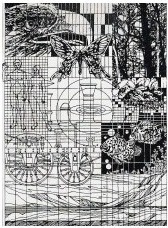An Electronic Newsletter
of EEA's Environmental Consulting Activities
Winter 2007
EEA, Inc.
55 Hilton Avenue,
Garden City, New York 11530
(516) 746-4400, (212) 227-3200
(800) 459-5533
additional New York offices:
Stony Brook
(631) 751-4600
Altamont
(518) 861-8586
Asheville, NC
(828) 777-0610 |
e-mail addresses:
General:
mailto:eea@eeaconsultants.com
Individual:
First initial and last name
@eeaconsultants.com
EEA services include
Phase I ESAs, Haz-Mat
Testing and Remediation, Wetlands
Delineation
and Creation, Natural
Resources Inventories,
Marine Ecology Studies,
Air Quality and Noise
studies, and Environmental Management
System (ISO 14000) implementation.
Visit our web site
at
http://www.eeaconsultants.com/
For information or quotes,
contact:
Phase II/III Haz-Mat
Testing and Remediation
Nicholas Recchia, VP, CPG
Dredge Management Testing
Jeffrey Shelkey
EAS/EIS Studies
Janet Collura, CWS
Marine Ecology
Michelle Nannen
Terrestrial Ecology
Denise Harrington, AICP
Air Quality and Noise
Victor Fahrer, P.E.
Environmental Management
Systms (ISO 14000)
Robert Clifford
Director of Strategic Planning
James McAleer
Director of
Business
Development
Brian Duggan, JD
EEA, Inc. –
Founded in 1979
Principals
Leland M. Hairr, Ph.D.
President
Allen Serper, M.S., P.E.
Vice President
Roy R. Stoecker, Ph.D.
Vice President |
|
|
With growing
concerns about increasing human population, the constant rising of
sea level and associated wetland losses, and the future of fresh
water supplies, protecting our waterways and water resources has
never been more critical. The importance of the natural processes
and the natural functions performed along the banks and shorelines
of streams, ponds and oceans can not be underestimated.
Recently more
and more professionals and government agencies are acknowledging the
relationship between human actions and the natural system and the
benefits of integrating new policies and design approaches which
seek to conserve and protect the environment and its natural
resources. This enriches mans’ experience of the built environment,
increasing the ecological value of the place as a habitat as well as
the visual quality associated with the place and its surroundings.
Although government agencies, such as the New York State Department
of Environmental Conservation
(NYSDEC), NYS Department of State (NYSDOS),
US Fish & Wildlife Service (USF&WS)
and US Army Corps of Engineers (USACE)
typically can not dictate what measures are to be used for a
specific project, they are supportive advocates when it comes to
solutions which conserve and protect the local natural resources.
The Natural
Process
Erosion along
streambanks and shorelines are a natural process when water
regularly interacts with the base of the bank. Wave activity, wind
and natural precipitation initiate a process of erosion along
streambanks and shorelines. Streams naturally erode their banks
along the outer toe of a meander bend while depositing sediment
along the inner meander bend, forming point bars. As more impervious
surfaces are created in watersheds, the flow regime changes, routing
more runoff to streams and less into the ground. The result is an
increase in stream velocity and energy and a subsequent increase in
streambank erosion.
The shorefront
fringe and its adjacent wetlands represent one of earth’s natural
ways of protecting its own resources and benefiting from natural
erosion and sedimentation. The freshwater wetland and tidal marsh
fringe along the shorefront perform many important functions
including nutrient and organic matter production and transport,
nutrient and contaminant removal, reduction of wave energy during
storms, flood water storage, and sediment trapping. Salt marsh areas
also provide critical habitat for the larval and juvenile stages of
many fish and invertebrate species, and are used for spawning by
adults of these species. Both freshwater and salt marshes are
important feeding and nesting grounds for many birds and other
vertebrate species.
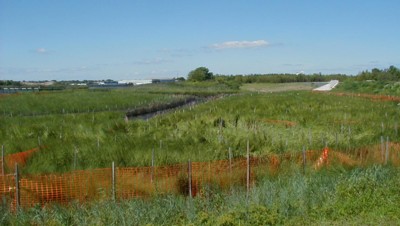 |
|
Fresh
Kills Landfill Restoration |
Human
Actions
Human actions,
policies and perceptions, such as the need for hygiene, irrigation,
sewer systems and stormwater discharges; construction and
development; recreational and commercial boating, to name just a
few, intentionally or un-intentionally, accelerate the degradation
of the worlds water resources. Protecting and restoring our
resources, allowing the natural processes to work for us, can be
beneficial to the publics’ health and needs as well as the health of
the natural environment. Aesthetics, recreation, public education,
and commercial benefits are only some of the potential values
derived from restoration activities and are important in garnering
initial and possible long term public and political support for any
project.
The Natural
Approach
The ‘natural approach’ to streambank
and shoreline protection is part of a growing trend in which
designers and other professionals seek to restore the hydrological
and ecological balance to a site by applying innovative integrated
solutions that are structurally sound, economical feasible and
ecologically sustainable.
There are two main forces at work
which affect the deterioration of a shoreline, the force of the
water against a streambank or a shoreline and the resilience of the
shoreline to external impacts - natural or not. In order to restore
and achieve a sustainable solution both forces must be recognized as
one system.
Restoration
and Protection
Streambank and shoreline protective
measures can be grouped into three main categories and are often
used in combination to achieve maximum effectiveness (US Army Corps
of Engineers, 1981)
1. Vegetative plantings
- Vegetative measures for
shoreline stabilization generally include installation of adapted
plants or seed mixtures applied alone on shallow slopes, flatter
than 3 foot horizontal to 1 foot vertical.
2. Soil bioengineering
- Applied on steeper slopes, plants
are typically used in conjunction with soil bioengineering systems
or other means of soil erosion control. Soil bioengineering is a
system that utilizes living plant materials as structural
components. Under this technique, adapted types of woody vegetation
are installed in specified configurations that offer immediate soil
protection and reinforcement. Additionally, soil bioengineering
systems create resistance to sliding or shear displacement as they
develop fibrous root systems (USDA
Natural Resources Conservation Service, 1996).
3. Structural measures
- Traditional structural measures
such as stone revetments, wooden or steel bulkheads and concrete sea
walls may be viable options or the only solution along very exposed
high energy shorelines. Structural methods of shoreline protection
are the least encouraged options. An order of preference has been
promulgated by regulatory agencies, listing vertical structures such
as bulkheads as the least preferred method of shoreline protection.
According to the NYSDEC, the presence
of bulkheads initiates a cycle where toe scour causes a deepening of
the water directly in front of the bulkhead; wave heights and
flooding may increase; and wetland areas that would naturally
attenuate wave energy and store flood waters are eroded away.
Structural measures that integrate
new erosion control technology together with vegetated measures are
often preferred. In fact, the NYSDEC now has requirements for dock
width and placement in inter-tidal marshes, flats, and adjacent
areas. Careful consideration must be given in the selection of
innovative measures and products versus more conventional
treatments.
Practice selection, design, sizing and installation are site
specific and priority should be given to measures that will restore
the hydrologic and ecological balance as well as to ensure longevity
and diversity along streambanks and shorelines.
Vegetative
Plantings
|
A good example of the use of vegetation alone for tidal
wetland restoration is the successful Hempstead Harbor Cove
|
|
|
| |
Project in Port Washington, Long Island. This
project included site cleanup, development and implementation
of restoration plans for a |
|
5-acre tidal cove located on
the south side of the Town
of North Hempstead’s Bar Beach Park. The overall plan
designed by EEA Inc. called
for the removal of the existing
layer of rock, rubble and assorted debris. In order to
reintroduce a viable and sustainable tidal regime, the
rubble debris and Phragmites rhizomes were excavated
and a layer of clean topsoil was applied and graded
carefully, providing a favorable planting medium. Native
vegetation introduced to the area was carefully selected to
achieve maximum diversity, longevity and overall success.
This project is also a good example of how policies, in
addition to a joint effort of the government agencies, the
local community and the design professionals all worked to
restore a healthier and aesthetically pleasing environment.
This restoration was accomplished as off-site mitigation for
a required cleanup of
the Shore Realty Superfund Site located on the opposite
shoreline of Hempstead Harbor. The project was partially
funded through a
NOAA/NMFS (National Oceanic & Atmospheric
Administration/National Marine Fisheries Service) community
assistance grant, with in-kind support from the Town of
North Hempstead. EEA Inc. designed and prepared the
site plans, obtained the wetland permits, then conducted
construction inspection, and assisted with on-site training
and overseeing the volunteers through the completion of the
planting phase. EEA Inc. is currently involved in the
long-term monitoring for this project. |
Soil
Bioengineering
|
Most recently installed and completed was a wetland creation
at Fresh Kills Landfill for New York City Department of
Sanitation (DSNY).
Soil bio-engineering was applied here as a part of a
mitigation process.
The project site is
adjacent to a new truck-to-rail
facility that has been |
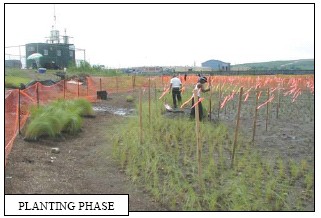 |
|
constructed north of Little Fresh Kill and Fresh Kills
Creek
within the
Fresh Kills Landfill. This represented a significant
mitigation ratio for anticipated losses associated with
construction of a proposed railway crossing and installation
of storm water filtration devices.
The project itself entailed removal of approximately 10 feet
of mixed refuse from the landfill shoreline and the creation
of a 3.1-acre tidal wetland with maritime shrub and
grassland plantings in the adjacent area. Specially blended
organic granular soil was placed and graded according to
specifications in the areas to be restored. Coconut fiber
logs were placed along the newly constructed shorelines to
minimize the natural bank erosion expected from the
anticipated tidal fluctuation. Heavy duty degradable erosion
control blankets, also known as geo-textiles, were place on
steeper slopes to help stabilize the slope, protecting seeds
and soil in place while allowing for the new vegetation to
establish. Waterfowl exclusion fences were also installed to
allow for the salt marsh vegetation to establish.
EEA Inc. provided the site plans as well as oversight
of the wetland planting for DSNY as a technical
sub-consultant to
HDR Engineering. Typically tidal wetland permits granted
by the NYSDEC require an additional 5-year monitoring
period. Due to the initial success of the project, the
agency has unofficially reduced the length of monitoring
time requirements. |
The Tidal Cove Brushmattress Installation at Spy Coast Farm
in Setauket,
| |
|
NY was another form of applied
bioengineering, which replaced a
more traditional structural
approach
using stone revetment. This
innovative "green shoreline"
solution was embraced by
NYSDEC as a natural alternative. |
| |
|
|
to conventional shoreline
hardening structures. While
this
bioengineering technique
is
typically applied in fresh-
water
riverine settings, it was adapted
to suit the tidal cove conditions
at this project site. EEA Inc.
designed and assisted with the |
|
|
|
|
installation of the brushmattress
to stabilize the bluff
face of the
tidal cove. A mixture of dormant, live willow stakes were
bundled into fascines at the
toe of the bank
and
also
staked onto the bluff face. Sapling salt shrubs were
installed through the brushmattress at the lowest elevation
on the bank that is subject to periodic tidal inundation. A
specially blended salt-tolerant seed mixture was applied to
the bluff face and native maritime shrubs were planted
through and above the spring tide zone to naturalize and
blend the treated slope into the adjacent native plant
communities and wetland areas. |
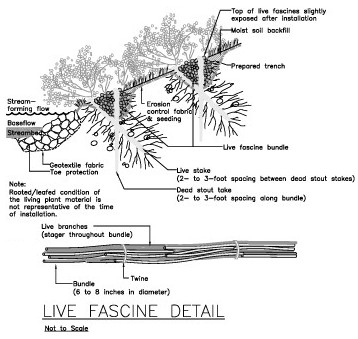 |
Source:
USDA Natural Resource Conservation Service. 1996. Streambank and
Shoreline Protection (Chapter 16– Engineering Field
Handbook). 210-vi-EFH. |
|
|
|
|
Structural measures are unavoidable in certain cases, however,
designers are now using new technology integrated with vegetated
measures to create ecologically viable, safe and sound, engineered
solutions. A good example of this approach was a project designed
by EEA Inc. on Staten Island, in which they first conducted
a feasibility determination for relocating a 1500-foot section of
a tidal creek, Purdy Creek, receiving waters from a nearby pond,
Wolf Pond. Purdy Creek Wetlands Creation and Stream Relocation |
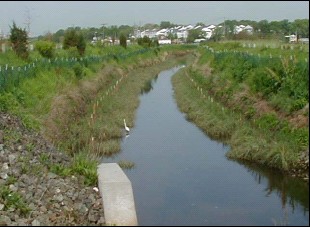 |
Project
included plans to upgrade the sanitary sewer lines in the area and
accommodate the development of a new gated residential community
on the waterfront. NYCDEP and NYSDEC approved the Stream
Relocation Plan. The EEA wetland team completed the planting
design and specifications, and conducted periodic inspections
during |
|
installation to meet agency performance criteria requirements.
The
original design included gabion baskets and coir palettes to help
stabilize the steep walls of the creek. During the construction
process a field decision was made to replace the gabion baskets
with geogrid covered by the coir palettes. EEA performed this work as an
ecological sub-consultant to
AKRF. This project cleaned up hazardous materials within the
creek, improved water quality, enhanced wetland habitat, and
provided project mitigation. |
|
